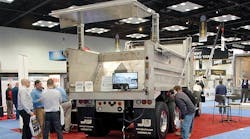NTEA often receives questions surrounding use of certification labels, manufacturer’s statement of origin (MSO) and second-stage manufacturer’s statement of origin (SSMSO). While these documents all come from motor vehicle manufacturers and include information to help identify specific vehicles, they serve entirely different purposes.
The certification label is part of the vehicle certification process and is a federal-level requirement that applies to all motor vehicles up to the first retail sale (meaning, up to the point a vehicle is licensed and titled in a given state). When a certification label is applied, it means the completed vehicle meets all relevant Federal Motor Vehicle Safety Standards. For the manufacturer, affixing the label is the last step in the certification process. Access the many NTEA articles on certification at ntea.com/federalregs (member login required).
An MSO, sometimes referred to synonymously as the manufacturer’s certificate of origin (MCO), and a second-stage manufacturer’s statement of origin (SSMSO) or its SSMCO counterpart (second-stage manufacturer’s certificate of origin) are state-level (not federal) requirements for motor vehicle licensing and titling. While these documents cover important details that would be included on the vehicle certification label (such as manufacturer name and VIN), the similarities are limited. Most vehicle information used by a state for establishing ownership, annual licensing fees and other purposes is unrelated to certification.
An MSO or MCO provides the same information for a vehicle that is built in a single stage. As trailers are typically constructed by a single manufacturer, the trailer manufacturer would issue this document for each new vehicle. The difference between a statement and certificate of origin is solely based on the paper format. Certificates are issued on banknote paper, which incorporates special security features to deter counterfeiting and fraud. Each state can choose to require a certificate or statement of origin.
Most NTEA members install bodies and equipment on vehicles produced in two or more stages. The truck chassis is the first stage, and body/equipment installation is the second. Some state regulations require upfitters to provide an SSMSO or SSMCO. However, the chassis itself will have a certificate of origin from the chassis manufacturer. Vehicle owners are typically required to have an MCO for the chassis and an SSMSO or SSMCO for the completed vehicle to provide to the state in which you intend to license and title the vehicle. You will want to first determine if the state(s) in which your vehicles will be licensed requires the certificate form of these documents and, if so, request it from the organization(s) building your vehicles.
A blurring of these requirements can occur as some states may additionally require a copy of the final-stage certification label as part of the licensing/titling process. Again, states have the ability to determine their own requirements for vehicle licensing and titling. However, it would not be unusual for states to choose to benefit from the fact that new vehicles manufactured in two or more stages must have a final-stage certification label. In this way, states can ensure that this federal-level requirement is fulfilled and provide another level of security demonstrating the vehicle is new.
With priorities turning toward vehicle cybersecurity, it is foreseeable that states will require more evidence during vehicle licensing and titling. Using existing federal-level requirements for vehicles and manufacturers could be a convenient way to enable more checks.
Certification labels can allow states to confirm that the final-stage manufacturer provided identifying information with the National Highway Traffic Safety Administration (NHTSA) as required under Part 566 of the Code of Federal Regulations. Beyond asking for the appropriate SSMSO/SSMCO documentation as part of your vehicle bid process, requesting the upfitter provide a copy of the NHTSA manufacturer identification record for their company is an upfront way to establish this requirement has been met. Doing so will help eliminate follow-up issues that could occur with a state or leasing company after vehicles are contracted and built. NTEA’s Member Verification Program (MVP) includes a requirement for Part 566 identification of manufacturers to NHTSA. MVP members (work truck industry companies recognized for outstanding business practices and successful implementation of quality standards) are identified in a dedicated directory (ntea.com/mvpdirectory). This listing can help your builder search in the bid/specification process.









